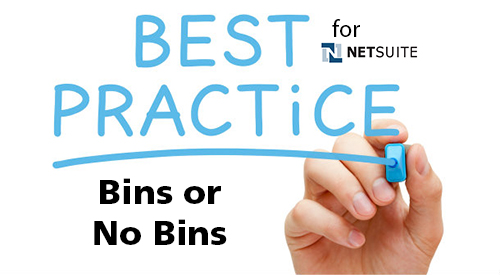
One thing to remember, as we get started, is that bins require specific warehouse processes to be followed. If these processes are followed, you will have inventory that is more accurate and faster to pick, as well as more accurate order fulfillment.
So, to bin or not to bin?
If your inventory fits the following conditions, then a no-bins environment may work for organization:
A no bins approach will allow you to perform inventory transactions that can create negative inventory, but this ability can also cause inventory or costing inaccuracies. If you like the flexibility though, a NetSuite inventory management solution that works with no bins can really help. And if any of these conditions change, you need to react quickly and move to bins before you create inventory issues.
Bins was a topic on this episode of the RF-SMART podcast. Listen in to learn how an RF-SMART customer is using bins in their facility.
Bins provide you better visibility to where inventory is stored in the facility, especially when the item is stored in more than one physical location. In addition, bins provide a number of other features that improve inventory and picking accuracy and warehouse performance:
If you are already live with NetSuite and are not using bins, the process of moving to bins is not as difficult as it might seem – although it should be performed by someone with the right tools and experience. There are many factors to consider when setting up a bin management system, including item characteristics, physical warehouse constraints, transaction volume and order mix.
After you’ve decided to move to bins, the next decision is to either use bin management or advanced bins. Here are some helpful tips for this step:
1. Decide how to layout your warehouse to provide the most efficient picking strategy.
The bin format needs to sort in the sequence that you want your employee to walk through the facility. The best way to validate this is to use an excel spreadsheet and sort the bins in a column.
2. Print bin labels with a barcode.
One of the best approaches is to print the label and then apply it to a magnetic sheet that can be stuck to the fixture. This will allow you to move or add bins in the future without having to scrape bin labels off the fixtures. RF-SMART can also assist you with different ways to print these labels that meet your warehouse environment.
Want to learn more? We dive into this topic in our "Bins or No Bins" webinar:
This is the third in a four-part guest blog series on NetSuite Best Practices. Our featured guest, George Gulliford, is the Director of Product Management at RF-SMART. With over 40 years of warehouse and logistics experience, George has assisted hundreds of companies in a variety of industries across the globe improve their operations.
Read part one to learn The Secret to Inventory Management, part two to learn Cycle Counting for Inventory Accuracy, and part four to learn Strategies for Retail.
Get a monthly recap of our latest Educational Content.
© 2025 RF-SMART. All rights reserved. Privacy Policy